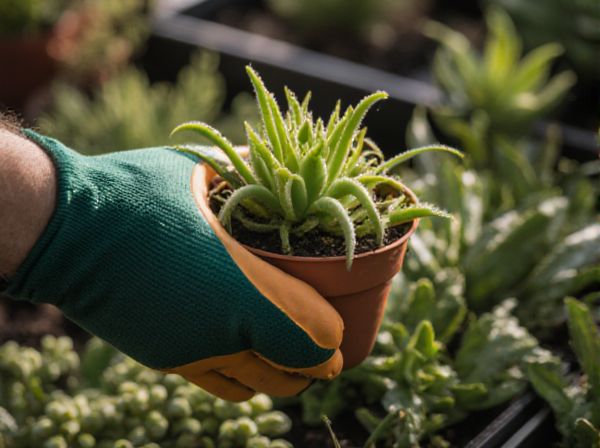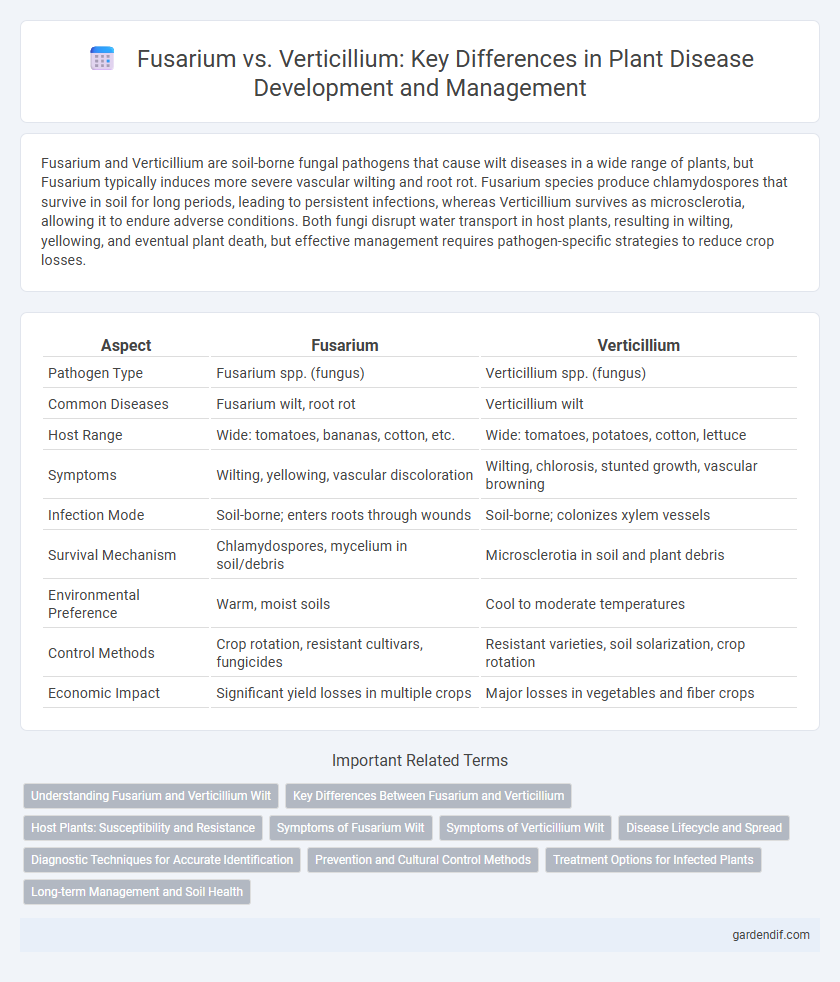
Fusarium vs Verticillium Illustration
Fusarium and Verticillium are soil-borne fungal pathogens that cause wilt diseases in a wide range of plants, but Fusarium typically induces more severe vascular wilting and root rot. Fusarium species produce chlamydospores that survive in soil for long periods, leading to persistent infections, whereas Verticillium survives as microsclerotia, allowing it to endure adverse conditions. Both fungi disrupt water transport in host plants, resulting in wilting, yellowing, and eventual plant death, but effective management requires pathogen-specific strategies to reduce crop losses.
Table of Comparison
| Aspect | Fusarium | Verticillium |
|---|---|---|
| Pathogen Type | Fusarium spp. (fungus) | Verticillium spp. (fungus) |
| Common Diseases | Fusarium wilt, root rot | Verticillium wilt |
| Host Range | Wide: tomatoes, bananas, cotton, etc. | Wide: tomatoes, potatoes, cotton, lettuce |
| Symptoms | Wilting, yellowing, vascular discoloration | Wilting, chlorosis, stunted growth, vascular browning |
| Infection Mode | Soil-borne; enters roots through wounds | Soil-borne; colonizes xylem vessels |
| Survival Mechanism | Chlamydospores, mycelium in soil/debris | Microsclerotia in soil and plant debris |
| Environmental Preference | Warm, moist soils | Cool to moderate temperatures |
| Control Methods | Crop rotation, resistant cultivars, fungicides | Resistant varieties, soil solarization, crop rotation |
| Economic Impact | Significant yield losses in multiple crops | Major losses in vegetables and fiber crops |
Understanding Fusarium and Verticillium Wilt
Fusarium wilt is caused by Fusarium oxysporum, a soil-borne fungus that invades plant roots and clogs vascular tissues, leading to wilting, yellowing, and stunted growth. Verticillium wilt, triggered by Verticillium dahliae and Verticillium albo-atrum fungi, similarly disrupts water transport but often causes more uneven leaf discoloration and branch dieback. Both diseases persist in soil for years, demanding crop rotation and resistant varieties as key management strategies.
Key Differences Between Fusarium and Verticillium
Fusarium and Verticillium are soil-borne fungal pathogens causing vascular wilt diseases but differ significantly in their host range and symptoms. Fusarium primarily causes Fusarium wilt, characterized by rapid wilting and yellowing of leaves, and often produces mycotoxins, while Verticillium wilt develops more slowly with chlorosis and vascular discoloration without toxin production. Fusarium species survive in soil and plant debris as chlamydospores, whereas Verticillium species form microsclerotia, influencing their persistence and control strategies in agricultural systems.
Host Plants: Susceptibility and Resistance
Fusarium primarily targets a wide range of host plants including cereals, legumes, and solanaceous crops, exhibiting high susceptibility in species like tomatoes and bananas due to its soil-borne nature and ability to persist in crop residues. Verticillium infects over 300 plant species such as cotton, potatoes, and some ornamentals, with resistance often observed in plants possessing robust vascular defense mechanisms to inhibit fungal colonization. Understanding genetic resistance traits and host-pathogen interactions is critical for managing Fusarium and Verticillium wilts in susceptible agricultural crops.
Symptoms of Fusarium Wilt
Fusarium wilt symptoms include yellowing and wilting of lower leaves, often progressing upward as the vascular tissue becomes discolored and brown. Plants exhibit stunted growth and leaf drop, with characteristic internal browning visible in stems when cut open. These symptoms contrast with Verticillium wilt, where foliar yellowing often appears in a more vascular pattern and may affect scattered leaves.
Symptoms of Verticillium Wilt
Verticillium wilt causes yellowing and wilting of leaves, often starting with lower foliage and progressing upward, accompanied by vascular discoloration visible as dark streaks in the stem. Infected plants exhibit stunted growth, leaf curling, and premature leaf drop, severely affecting overall plant vitality. Unlike Fusarium wilt, Verticillium wilt symptoms typically develop more slowly and can persist in soil for many years, posing a long-term threat to susceptible crops.
Disease Lifecycle and Spread
Fusarium and Verticillium diseases exhibit distinct lifecycles influencing their spread; Fusarium primarily survives in soil and plant debris as dormant chlamydospores or mycelium, spreading through infected seeds, soil, and water movement, while Verticillium persists in soil as microsclerotia and infects plants through root wounds. Both pathogens colonize the vascular system, causing wilting, but Fusarium's lifecycle is often accelerated by warm, moist conditions, whereas Verticillium thrives in cooler, temperate climates. Effective disease management relies on understanding these pathogen-specific survival structures and environmental preferences to limit their dissemination and crop damage.
Diagnostic Techniques for Accurate Identification
Accurate identification of Fusarium and Verticillium species relies on a combination of molecular diagnostics and morphological analysis, with PCR-based assays targeting species-specific DNA sequences providing high sensitivity and specificity. Culturing techniques on selective media facilitate the observation of distinctive colony characteristics, while microscopic examination reveals differences in spore morphology essential for differentiation. Advanced methods such as quantitative PCR and DNA barcoding enhance rapid detection and allow precise discrimination between these soil-borne fungal pathogens, crucial for effective disease management.
Prevention and Cultural Control Methods
Effective prevention of Fusarium and Verticillium wilt hinges on crop rotation with non-host plants and using disease-free seeds or transplants to minimize pathogen introduction. Soil solarization and organic matter incorporation improve soil health, suppressing pathogen survival and enhancing microbial antagonists. Proper irrigation management avoiding waterlogging and maintaining balanced fertilization reduce plant stress, increasing resistance to both Fusarium oxysporum and Verticillium dahliae infections.
Treatment Options for Infected Plants
Fusarium-infected plants often require soil fumigation, resistant cultivars, and fungicide applications such as thiophanate-methyl to manage disease spread effectively. Verticillium treatment emphasizes crop rotation with non-host plants, use of resistant varieties, and soil solarization to reduce pathogen presence. Both diseases benefit from proper sanitation and avoiding overhead irrigation to limit pathogen dissemination.
Long-term Management and Soil Health
Fusarium and Verticillium wilt diseases require integrated long-term management strategies including crop rotation with resistant varieties, soil solarization, and organic amendments to suppress pathogen populations. Maintaining soil health through improved organic matter, balanced fertilization, and promoting beneficial microbial communities enhances resilience against these soilborne fungi. Regular monitoring and employing biological control agents can reduce disease incidence and sustain productive soil ecosystems over time.
Fusarium vs Verticillium Infographic

 gardendif.com
gardendif.com